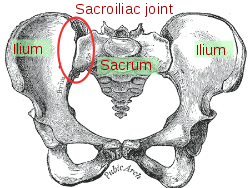 The sacroiliac joint is a mysterious beast. Many people don't know they have one...let alone 2. As the name suggests they sit between your sacrum and ilia, To put that in perspective the sacrum is the triangular bone made of (usually) 5 fused vertebrae, which in turn provides a base for the flexible bit of your spine and sits above your coccyx. The ilium (singular for ilia) is the top bit of your ironically named innominate bone (ironic as innominate means un-named and that is its name). The sacroliliac joint does not move much, in fact, for years much of the medical profession said that it didn't move at all in adults over 40, most osteopaths disagreed vehemently. So what is the truth and why does it matter? The truth is that the joint, in most people, is very robust, the ligaments holding it together are often cited as the strongest in the body and the joint has large articular surfaces which are rough and are keyed together greatly reducing the chances of movement of one against the other. In cadavers there is a tendency for tissues to be less stretchy and as such the sacroiliac joints do appear immobile, hence the previous medical consensus that they fuse in old age. Many osteopaths, myself included are convinced we can feel a pelvic torsion, where one sacroiliac joint has rotated anteriorly or posteriorly, or slipped in the vertical plane versus the other, twisting the pelvis. We use bony landmarks and judge whether they are at the same height as the other side front and back to make our assessment. Often the discrepancy can feel quite extreme and can appear to result in a leg length difference and can result in the base of the spine appearing twisted or at an angle to the vertical, which in turn can cause a scoliosis. Scientists have been trying to work out what is happening and whether what we feel is what we think we feel. Over the next couple of weeks I will be reviewing the research I can find on the matter and presenting to you what I find...It may be I have alter my explanations of what I am finding and what I am doing to change that.
0 Comments
Your comment will be posted after it is approved.
Leave a Reply. |
Archives
February 2024
AuthorDamian is the principal osteopath at Vauxhall Village Osteopathy and Oval Osteopathy Categories
All
|


 RSS Feed
RSS Feed


